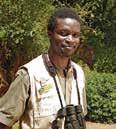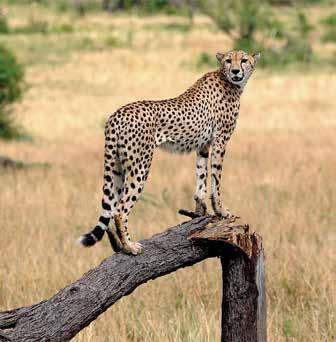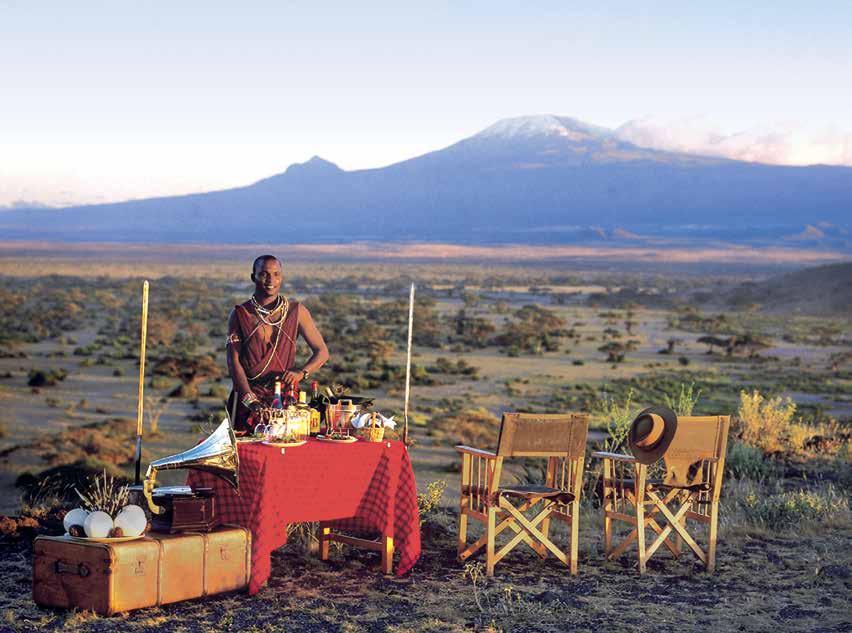




Dazzles of zebra, leaps of leopards, troops of baboons and crashes of rhino: these terms for herds become everyday vernacular during your oncein-a-lifetime Africa experience. Yet safari decorum proves far from second nature and knowing what to expect remains enigmatic for even the most voracious traveler. We turn to Micato Safaris to share insights with you that only a company named # 1 World’s Best Safari Outfitter by Travel + Leisure for nine years could provide.
This Nairobi-based and family-owned company has provided a range of safari adventures since 1966 and has fine-tuned the upscale safari adventure. Masters of the unexpected extras, Micato Safaris welcomes you into the home of owners Felix and Jane Pinto. They also finance the education of an African child with each safari sold — an initiative administered by their 25-year-old non-profit organization, AmericaShare. But selecting Micato to serve as ambassadors of the safari experience isn’t based on their impressive litany of offerings — although guaranteed departures, 24-hour concierge teams, exquisite camps and private jet itineraries are certainly impressive. Rather, it’s the team’s dedication to only hiring local guides from within Africa and Safari Directors who are the top graduates from Africa’s most esteemed university for wildlife conservation that made us certain they could best provide us with unadulterated advice. We asked six of the safari guides to share their deep comprehension for culture that comes from living it day to day to present you with unparalleled safari insights.

Gold Guide Philip Kibet Rono is often heralded as the #1 guide in Africa. During his 25 years with Micato, leading safaris through Kenya, Tanzania and Rwanda, he’s captivated guests’ imaginations with tales of growing up in Kenya’s highlands.

Born in England, South Africa-based Fran MeyerGebhardt celebrates her role as an Africanby-choice. Passionate about tourism and wildlife, she joined Micato in 2003 and accompanies guests from Zambia to Kruger National Park. Her favorite safari spot? Botswana’s Okavango Delta.

Nine-year Micato veteran and Bronze Guide, George Magambi Omuya never tires of his job. During safari this Nairobi-born guide’s greatest goal is to answer guests’ questions about African life past and present — including poaching, rites of passage and cultural diversity.

Proud South African Alan Petersen exemplifies the incredible mélange of cultures in his country. He relishes the opportunity to share his local insights about South Africa’s evolution and enjoys introducing guests to African residents that embody their unique interests.

With abundant curiosity and a ready laugh, Silver Guide Denis Simi learned to respect nature early during his childhood in Kenya’s Kisii Highlands. Committed to conserving the country’s biodiversity, he enjoys teaching clients about everything from insects to elephants.

Just call Kennedy Omwenga “Chief.” Though trained as a teacher, Silver Guide Kennedy was elected to lead his community after the death of his father. His details about traditional cultures fascinate guests during treks that include Rwanda and Kenya.


QWhat time of year proves best for safaris?
AFran Meyer-Gebhardt: Anytime is a good time; it simply depends on the type of experience you want and where you plan to safari. July through October you can witness the Great Wildebeest Migration, when nearly 1.5 million wildebeest — as well as the gazelle and zebra traveling in tandem — move en masse from Tanzania’s Serengeti National Park to Kenya’s Maasai Mara National Reserve. Considered, one of the “New Seven Wonders of the World,” the Migration is spectacular. South Africa has no herds, but wildlife abounds year-round. During dry season, May through October, animals congregate by waterholes, allowing visitors the chance to see various species at once. It’s always a wonderful surprise for our guests when they realize just how close they can get to the animals. To be in the middle of a herd of buffalo or a pride of lions, or to experience the thrill of a leopard brush past the vehicle is a life-changing moment. Of course, we never move into an animal’s space. We wait, watch, and only move closer when appropriate. It’s a very rewarding experience to see these animals relaxed in our company. If I could pick only one experience for someone, it would be a safari in Botswana — just north of South Africa — where you can experience land and water excursions in the unique Okavango Delta, the largest of its kind in the world.
After determining the “when” and “where,” what other factors influence selecting a safari?
Denis Simi: Since there isn’t just one way to experience this adventure, choosing a safari outfitter that can tailor your itinerary to meet your needs is key. From intimate explorations to large group outings, posh accommodations or more rustic lodgings, safaris vary as much as any vacation. Despite the primitive bush setting, exclusive lodges are quite luxurious, with spas, gourmet dining and service you’d find in a five-star hotel. At Micato we choose only the best small camps and game reserves. It’s our desire to make you feel as though you are the only human beings out in the bush. For example, in Tanzania’s Serengeti an “Out Of Africa” experience recreates the days of Karen Blixen and Ernest Hemingway in an upscale tent camp. Your individual tent suite, a dining tent — even a canvas-roofed library with oriental carpets, thumb-worn books, telescopes and a whiskey bar — all provide nostalgic nods to this former heyday. Active travelers may prefer heading out on horseback, riding from one mobile, outdoor camp to another. If someone is seeking seclusion, they might choose a luxury villa with all the extras such as private pool, a dedicated staff and personal chef. Selecting the type of safari is unique to the traveler and each offers something new.
Though grew up in Kenya, every single safari for me is a magical adventure that
of elephants walking in a line holding onto trunks and tails, it is believed elephants travel this way to protect their young and are usually led by a female. THIS PAGE: Gallop across the Serengeti plains traveling among a herd of zebra as you take a day ride or set out on an equestrian safari in Tanzania.
PAGE: Luxuriate at Singita Boulders Lodge, an inviting oasis where organic interiors blend seamlessly with the raw African landscapes.
adds meaning to my life. I love standing atop a promontory watching the sunset, riding a horse through the bush and forming bonds with many guests that last a lifetime. Many of the guides from the lodges are of the Maasai community in Kenya and have as many questions about life in America as you do about Africa. Together, we learn from one another. Are game drives usually done via Jeep?
Alan Petersen: While open-air safari vehicles tend to be the most popular way to set out for a game drive, how you experience the bush can be as unique as your interests. Many safaris start out by bringing you to a remote region by bush plane. Trekking the savannah on foot accompanied by a guide instills you with a wonderfully quiet connection to the land and horseback lovers can see it all from the saddle. In South Africa, we put people on the backs of elephants and let them thunder through the veld. For one biking enthusiast we even arranged a bicycle game drive in Kenya’s Chyulu Hills. At Botswana’s Okavango, a safari by canoe gives you a completely different vantage point of the surrounds. Honestly, the sky’s the limit. often recommend setting out over the Maasai Mara in Kenya in a hot air balloon. Looking down, it is like a miniature world in play; the entire landscape teems with simultaneous action where warthogs gambol, hyenas trot and elephants trudge. PREVIOUS


What does a game drive entail?
Philip Kibet Rono: Typically safari companies offer both morning and late afternoon game drives, which can last three to four hours depending on what you see. Some guests and guides prefer the morning, when we see the animals waking and becoming active. As an ornithologist, I am delighted to point out the hundreds species of birds — their distinct calls most easily heard at that time of day. After the morning drive, guests return to an immense breakfast spread then spend the day reading, enjoying the spa, or playing board games in the lodge’s library. And, you can always head out on another game drive in the afternoon, too, if you wish. The second half of the day brings hungry animals, just awakening from their naps. This is a great time to see active wildcats and elephant families gathering in open fields. Local guides tend to know where animals are most likely to be found. But one of the most exciting aspects of a safari is that you never can predict what the day may bring — it could be a mother cheetah and cubs, a group of monkeys, giraffes or all of the above. When animals are spotted, I quietly describe each creature’s unique habits and habitat. In between, we point out native trees and flowers and discuss Africa’s history and culture. At Micato we design the schedule around what each guest enjoys,
but one thing most seem to agree upon is ending the day with a relaxing sundowner. What exactly is a sundowner?
Alan Petersen: Let me paint the picture for you. Imagine that you’ve been driving through the bush for a couple of hours and the sun is setting over the horizon. You feel the warmth coming up from the ground and the sky takes on various shades of orange as nightfall approaches. Your guide offers you biltong (a variety of cured meats) to complement your drink, be it a gin and tonic or chilled Stellenbosch chardonnay. Then, you stand back and reflect on the day’s activities and sightings. You share stories with your companions. You smile and say to yourself, “This is Africa. I am really here.” Dusk is such a special time of day in the veld or bush and we do whatever we can to make sundowners magical. One guest in Kenya looked forward to sundowners so much, we schemed all day how to surprise her with something more exciting than the day before. We served her cocktails next to a waterfall, atop a massive rock promontory and on a grassy airstrip watching the bush planes land. One of her favorites was the sundowner on a riverbank, where we were surrounded by baboons. At each newfound spot, we shared the enchanted spectacle of the sun disappearing into the dramatic acacia trees.
What can one expect when it comes to dining?
Philip Kibet Rono: Dining is another important factor to consider when choosing a well-suited safari outfitter, as I find attention to cuisine greatly varies. It’s one of my favorite parts of the experience. Such as private dining in the gorgeous walled garden near the lodge at Bushmans Kloof Wilderness Reserve & Wellness Retreat, let yourself enjoy a sumptuous spread prepared especially for you. We understand that certain guests have special dietary needs, so we’ve flown in soymilk for lactose intolerant travelers and turned a lodge kitchen into a kosher cookery. And for us, dining is not only a time to celebrate regional flavors, it’s a time to satiate cultural curiosities. Micato’s owners, the Pintos, will invite you to have lunch or dinner with them at their home in Nairobi along with prominent Africans. We’ve invited members of the Leakey family to share meals with anthropology buffs. Professors have dined with historians, politicians with mayors and opera singers with local musicians. Recently, I had a guest on a Kenya trip who loved her Micato pillow gifts of Kenyan-made jewelry so much, that when the Pintos heard about it they devised a plan to introduce her to the artist. Not only did the guest share a meal with the artist, she was given a personal tour of the artist’s studio.

In what ways do travelers experience local culture?
Kennedy Omwenga: Guides often introduce guests to members of the local communities to share how their lifestyles are still lived in a traditional manner. You might be treated to a dance performance, be invited to watch artisans at work making crafts or gather in a tribesman’s straw to discuss tribal history and culture. Not only do we at Micato make this an important part of the safari experience, the Pinto’s long-term dedication to hiring local guides provides our guests with even more insider knowledge. I am a perfect example of this commitment. I grew up in a tiny village not far from the Maasai Mara. As a young boy in the Kisii tribe, I tended goats in the highlands and when I reached warrior age, I spent days tracking game, big and small. During this time, I developed a sixth sense about animal behavior so I bring this talent to the safari, enlightening my guests with
anecdotes and discoveries in the bush. When not traveling the continent for Micato, I return to my village, where today I serve as chief, and live a traditional bush lifestyle.
There is a trend of eco-consciousness and social awareness in today’s travel. How does this translate to the safari adventure?
George Magambi Omuya: As the cradle of humankind, Africa and its vast expanses remind us of the importance of caring for the earth. As nations across the globe commit to recycling, solar power and the preservation of land and indigenous cultures, so does Africa. Safari outfitters can really make a big difference. They help train local communities to favorably take advantage of their natural resources, aid in funding schools and succeed in creating jobs. Micato’s relationships with national parks and land management teams at small reserves provide guests with opportunities
to visit schools, churches and private homes. We like to show guests that Africa is not just about wildlife, but about people, too. For example, in the Maasai Mara we spend an afternoon with the Maasai, Africa’s famous warrior and cattle raising tribe, learning about the centuries-old lifestyle they continue to embrace. East African safaris always end with the option to visit the Micato-funded community center in Mukuru, an underprivileged part of Nairobi, with a member of the Pinto family. During this heartfelt experience, guests often purchase gifts, plants, trees and books to give to locals. One guest told me that being surrounded in his safari vehicle by a herd of elephants had been the most meaningful day of his life — until the trip to Mukuru. He said it outshone even his exuberant sightings of the Big Five, times ten. Please contact us or turn to page 64 for more information on Micato Safaris and for a selection of ULTIMATE EXPERIENCES.
THIS PAGE: Micato Safaris provide up-close encounters with Africa’s exotic creatures; Your safari directors help you spot wildlife such as the leopard lazing in branches overhead. OPPOSITE PAGE: The setting sun casts a magical hue over the sundowner prepared for you on the southwestern rim of Tanzania’s Ngorongoro Crater.